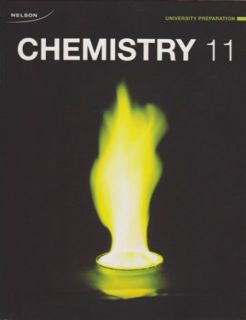Suppliers
Other Departments
Shop by Brand
More Information
.png)

Suppliers > Nelson Education Ltd.
Nelson Chemistry 11 University Preparation
Model: 9780176510381
The Nelson Chemistry 11 University Preparation - Student Textbook supports the Ontario Ministry of Education
Course: Chemistry, Grade 11, University Prepration, Course Code: SCH3U
Author Team: Stephen Haberer, Kristina Salciccioli, Milan Sanader
It has these units and chapters:
Unit 1: Matter, Chemical Trends, and Chemical Bonding
Chapter 1: Atomic Structure and the Periodic Table
1.1 The Nature of Chemistry
1.2 Atomic Structure
1.3 Ions and the Octet Rule
1.4 Isotopes, Radioisotopes, and Atomic Mass
1.5 The Periodic Table and Periodic Law
1.6 Chemistry Journal: A Not-So-Elementary Task
1.7 Periodic Trends in Atomic Properties
Investigation 1.4.1: The Nuts and Bolts of Atomic Mass
Investigation 1.5.1: The Search for Patterns
Investigation 1.7.1: Graphing Periodic Trends
Chapter 2: Chemical Compounds and Bonding
2.1 Ionic Compounds
2.2 Molecular Elements and Compounds
2.3 Chemical Bonding and Electronegativity
2.4 Chemical Formulas and Nomenclature
2.5 Explore an Issue in Chemical Compounds: Sugar versus Artifical Sweeteners
Investigation 2.1.1: Comparing Ionic and Molecular Compounds
Investigation 2.4.1: Ionic or Molecular?
Chapter 3: Molecular Compounds and Intermolecular Forces
3.1 Molecular Compounds
3.2 Explore an Issue in Molecular Compounds: DEET in Insect Repellents
3.3 Polar Bonds and Polar Molecules
3.4 Intermolecular Forces
3.5 Hydrogen Bonding and Water
3.6 Green Chemistry in Action: Choosing the Right Materials
Investigation 3.4.1: Melting Points of Molecular Compunds
Investigation 3.5.1: Surface Tension and Intermolecular Forces
Unit 2: Chemical Reactions
Chapter 4: The Effects of Chemical Reactions
4.1 Introduction to Chemical Reactions
4.2 Synthesis and Decomposition Reactions
4.3 Explore an Issue in Chemical Reactions: Garbage Gasification - A Heated Debate
4.4 Single Displacement Reactions
4.5 Chemistry Journal: The Mystery of the Missing Mercury
4.6 Double Displacement Reactions
Investigation 4.4.1: Hydrogen Blast-Off
Investigation 4.4.2: An Activity Series of Ions
Investigation 4.6.1: Precipitate Patterns
Chapter 5: Chemical Processes
5.1 The Combustion of Hydrocarbons
5.2 Chemistry Journal: The Role of Chance in Discovery
5.3 Elements and Their Oxides
5.4 Neutralization Reactions
5.5 Mining. Metallurgy, and the Environment
5.6 Detox for Contaminated Land
5.7 Green Chemistry in Industry
Investigation 5.1.1: Combustion of Ethyne
Investigation 5.3.1: Properties of Oxides
Investigation 5.4.1: Neutralizing Pain Relievers
Unit 3: Quantities in Chemical Reactions
Chapter 6: Quantities in Chemical Formulas
6.1 Qualitative and Quantitative Analysis
6.2 Explore an Issue in Chemical Quantities: Overdosing on Salt
6.3 The Mole - A Unit of Counting
6.4 Molar Mass
6.5 Mass and Number of Entities
6.6 The Composition of Unknown compounds
6.7 Empirical Formulas
6.8 Chemistry Journal: Drug-Contaminated Currency
6.9 Molecular Formulas
Investigation 6.6.1: Popping Percentage Composition
Investigation 6.6.2: Percentage Composition of Magnesium Oxide
Investigation 6.9.1: Determining the Formula of a Hydrate
Chapter 7: Stoichiometry in Chemical Reactions
7.1 Mole Ratios in Chemical Equations
7.2 Mass Relationships in Chemical Equations
7.3 Which Reagent Runs out First?
7.4 Calculations Involving Limiting Reagents
7.5 Percentage Yield
Investigation 7.2.1: What Is Baking Soda Doing in Your Cake?
Investigation 7.4.1: Copper Collection Stoichiometry
Investigation 7.5.1: What Stopped the Silver?
Unit 4: Solutions and Solubility
Chapter 8: Water and Solutions
8.1 The Importance of Water
8.2 Solutions and Their Characteristics
8.3 The Dissolving Process
8.4 Explore an Issue in Solutions: Oil Dispersants - Is the Fix Worse than the Problem?
8.5 Solubility and Saturation
8.6 Concentration
8.7 Preparing Dilutions
8.8 Concentrations and Consumer Products
Investigation 8.6.1: Preparing a Standard Solution from a Solid
Investigation 8.7.1: Preparing a Standard Solution by Dilution
Chapter 9: solutions and Their Reactions
9.1 Reactions of Ions in Solution
9.2 Water Treatment
9.3 Chemical Analysis
9.4 Chemistry Journal: Drugs in Drinking Water
9.5 Stoichiometry of Solutions
Investigation 9.2.1: How Effective Are Water Filters?
Investigation 9.3.1: Cation Qualitative Analysis
Investigation 9.5.1: Percentage Yield of a Precipitation Reaction
Chapter 10: Acids and Bases
10.1 Properties of Acids and Bases
10.2 Theoretical Acid-Base Definitions
10.3 Acid-Base Stoichiometry
Investigation 10.2.1: Not All Acids Are Created Equal
Investigation 10.3.1: Standardization of a Sodium Hydroxide Solution
Investigation 10.3.2: What is the Amount Concentration of Ethanoic Acid in Vinegar?
Unit 5: Gases and Atmospheric Chemistry
Chapter 11: The Gas State and Gas Laws
11.1 States of Matter and the Kinetic Molecular Theory
11.2 The Atmosphere and Its Components
11.3 Chemistry Journal: The Road to Discovering Argon
11.4 Air Quality
11.5 Indoor Air Quality
11.6 Explore an Issue in Atmospheric Chemistry: Car Idling
11.7 Atmospheric Pressure
11.8 The Gas Laws - Absolute Temperature and Charles' Law
11.9 The Gas Laws - Boyle's Law, Gay-Lussac's Law, and the Combined Gas Law
Investigation 11.4.1: Comparing Air Quality in Several Locations
Investigation 11.9.1: The Relationship between Volume and Pressure
Chapter 12: Gas Laws, Gas Mixtures, and Gas Reactions
12.1 Avogadro's Law and Molar Volume
12.2 Ideal Gases and the Ideal Gas Law
12.3 Chemistry Journal: The Science of Cold
12.4 Gas Mixtures and the Law of Partial Pressures
12.5 Reactions of Gases and Gas Stoichiometry
12.6 Explore Applications of Gases: Burning Snowballs
Investigation 12.4.1: Determining the Molar Mass of Butane
Investigation 12.5.1: Gas Stoichiometry: Determining the Mass of Hydrogen Gas
For each chapter, there are Summary, Self-Quiz and Review.
For each unit, there are Task, Self-Quiz and Review.
Numerical and short answers are given at the end of the textbook.
Hardcover, 698 pages, book size: 22 cm x 28 cm. x 3.1 cm




